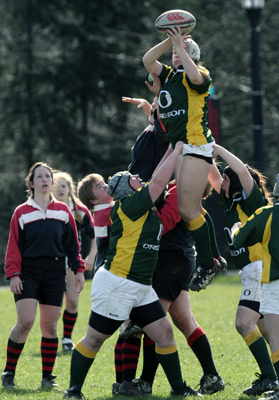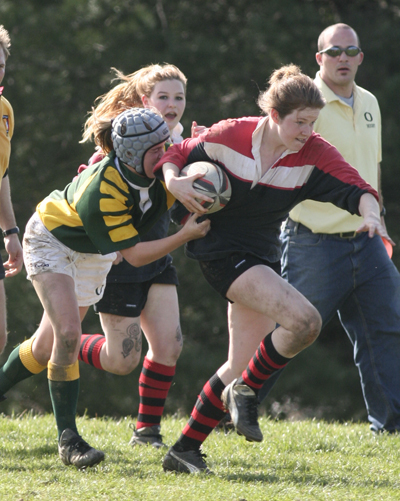
Sports
- The Outdoor Program helps people plan adventures.
- Adam Lake uses fencing to bring people together.
- Win or lose, the Pit Crew keeps Mac Court shaking for the Ducks.
- Tearing at jerseys and slamming into each other. It's women's rugby.
Changes
- A Taiwanese student finds adjusting to a foreign culture challenging.
- A student TV show features news, sports, drama and comedy.
- A close-up look at the ASUO president.
- A senior's abrupt transition to Eugene after Hurricane Katrina.
Arts
- A ballroom dance club president wears many hats and makes them too.
- Whether composing or jamming on his mandolin, Jesse Jones shares his love of music.
- Non-traditional African dance brings a new sense of community.
- The Student Fibers Guild proves that knitting isn't just for old ladies anymore.
- Halo Jones' music and art expresses his dark and light sides.
- A musician, student, activist and artist.
- For Ashley Maury, jewelry is more than decorative.
- A student TV show features news, sports, drama and comedy.
- A printmaking student goes beyond the studio and into the city.

By tearing at jerseys and slamming into each other, athletes
drive their competition into the ground. It's all part of
women's rugby at the University of Oregon.
By Rebecca Taylor
“OK, now run at me,” Bergen says as one of the women readies herself for the lesson. She slams her body weight into Bergen, who grabs the back of her shirt and drags her to the ground. “Rugby shirts don’t tear for a reason,” he says. “Use them.”
Another player slams into Bergen again, this time with a crunch and a squeal from the player. “Don’t do that in the game on Saturday,” All-American Krista Gust says. “Don’t yelp during a play.”
|
The University of Oregon club women’s rugby team is second in its league with a 3-0 record. The team lags behind Reed College, which has played one more game than the University. League standings are based on total points, and the more games a team has played, the higher points it will have.
The team also shares the league with Western Washington University and Oregon State University. The team played Reed on March 4 in Portland, Ore., and lost to the league leader.

When a ball goes out of bounds, players line up to catch it as it is thrown back in. Players wrap their hands in the shorts of their catcher and launch her into the air to gain advantage over the other team. |
The team flew to California last month to play in an out-of-league tournament that attracted powerhouse teams from a few West Coast schools and several schools on the East Coast. The tournament games were against Stanford, to whom the Ducks lost 26-5. The Ducks defeated UC Santa Barbara 19-7; then, in a match against Radcliffe, the Ducks won 19-7. The team finally lost to James Madison 22-5.
Rugby is played with 15 players on per team. Each number on a jersey represents a position on the field, rather than a specific player, unless that player plays only one position. On the women’s team, many players play different positions and because of low funding through the University’s Club Sports program, there is only one jersey per number. So, when substitutions are made, the women strip off their jerseys and switch them out with the new player.
Rugby is a full-contact sport, which resembles, in layman’s terms, a mismash of football and soccer. Players cannot block each other, and full-out tacking is permitted. Once you are tackled, you must intentionally and immediately drop the ball so you don’t slow play.
More information
|
Players can pass the ball only to others behind them. There is no Hail-Mary, no forward pass to keep the ball moving down the field. The players run the ball, tripping, tackling, grabbing and knocking each other down in order to reach the goal.
There are only three ways to score in rugby. Five-pointers are scored with a “try,” or a touchdown. The player must cross into the end zone with the ball in her hands and then touch the ball to the ground in order to get the points. Two points are earned after a touchdown by a field goal – much as in American football because the ball is raised onto a tee and the kicker is given enough time to kick. Three-pointers are scored by kicking a field goal that is not affiliated with a touchdown.

A Reed player runs the ball down the field as an Oregon forward grabs on in an attempt to stop her. Coach Justin Bergen looks on in the background. |
The scrum, something of a rugby huddle, is formed after a penalty, or after play has been stopped. To begin play once again, the referee throws the ball into a mass of players from both teams. The scrum is made up of eight players from each team who crouch beside one another and lock arms. Play starts as the ball is thrown and 16 women fight for possession. Once possession has been obtained, the women fight their way down the field until they reach the end zone.
Rugby has a no-holds-barred attitude toward pain and injury. Learning how to fall is paramount, which is why coach Bergen spends so much time teaching the women how to tackle correctly.
“Pull her to the ground, then step around and grab the ball,” Bergen says. He shows the women how to use their opponents’ body weight against them in order to effectively retrieve the ball.
The women line up again and again, practicing how to hit, how to tackle and how to fall. They laugh and joke together, teasing and pushing each other to be better. They push each other to hold onto the ball tighter, to not fall if they can help it, and to be tough when they fall too hard. All in the name of a sport that is unforgiving in it brutality but brings the Duck team together to fight for a win.